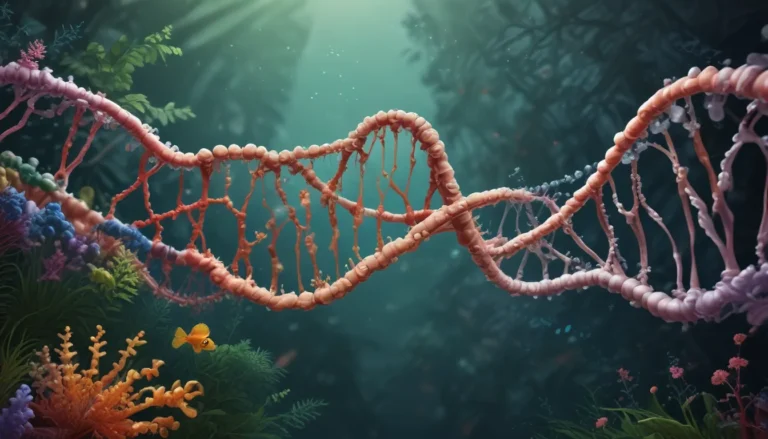A Note About Images: The images used in our articles are for illustration purposes only and may not exactly match the content. They are meant to engage readers, but the text should be relied upon for accurate information.
Exploring the intricate world of chemistry unveils a captivating phenomenon known as denaturation. This process, which alters the structure of proteins, is a treasure trove of astounding facts waiting to be discovered. From the impact of heat and pH on proteins to its role in cooking, lab experiments, and even allergies, denaturation is a pivotal concept in the realm of science. Whether you’re a chemistry aficionado or simply curious about the wonders of the natural world, delving into the world of denaturation will broaden your horizons and deepen your appreciation for the marvels of science. Join us on a journey through 19 intriguing facts about denaturation that will pique your curiosity and enrich your understanding of this mesmerizing process.
Understanding the Essence of Denaturation
Denaturation involves the alteration of proteins’ native conformation, leading to a loss of their biological activity. Various factors such as heat, pH changes, exposure to chemicals, or mechanical agitation can trigger this transformative process. Let’s unravel the key aspects of denaturation and its impact on the world of biochemistry.
The Influence of Heat on Denaturation
Heat serves as a common catalyst for protein denaturation. When proteins are subjected to high temperatures, the weak bonds holding their structure together are disrupted. As a result, proteins unfold and lose their functional shape. In most cases, this denaturation process is irreversible, highlighting the profound impact of heat on protein stability.
The Role of pH in Protein Denaturation
Apart from heat, changes in pH can also instigate protein denaturation. Proteins have an optimal pH range for optimal functioning, and deviations from this range can disrupt their electrostatic interactions, leading to denaturation. Understanding the delicate balance of pH is crucial in maintaining protein integrity and functionality.
- Denaturation isn’t just about proteins – it also affects DNA. It’s reversible for DNA, but not always for proteins. This process is crucial in cooking, medicine, and understanding our bodies.
The Impact of Chemical Agents on Denaturation
Chemicals such as acids, bases, and salts can induce protein denaturation by altering the charges on amino acid residues. Strong acids or bases can disrupt interactions within the protein structure, while certain salts can upset the balance of ions, leading to structural changes in proteins. This underlines the diverse mechanisms through which denaturation can occur.
Delving into Denaturation’s Effects
As proteins undergo denaturation, significant changes manifest in their physical properties. Protein solubility in water may diminish, texture and color may alter, and taste may be affected. These modifications can render proteins less appealing or useful in various applications, showcasing the transformative power of denaturation.
Unveiling the Biological Implications of Denaturation
Proteins play crucial roles in biological processes, from enzymatic reactions to immune responses. Denaturation can disrupt these functions, rendering proteins inactive or less effective. Understanding the impact of denaturation on biological activity is essential in comprehending the intricate workings of living organisms.
The Concept of Reversibility in Denaturation
Although denaturation is often deemed irreversible, certain proteins can regain their native conformation under favorable conditions in a process known as renaturation. This phenomenon underscores the dynamic nature of protein structure and the potential for restoration after denaturation.
Practical Applications of Denaturation
Denaturation isn’t just a scientific concept—it also finds practical applications in food preparation and laboratory techniques. Cooking processes like coagulation of egg whites and grilling of meat rely on protein denaturation to achieve desired textures and flavors. In laboratory settings, denaturation is instrumental in protein separation and analysis techniques.
- Denaturation might just represent a new leap forward in understanding the building blocks of life.
Navigating the Maze of Denaturation in DNA
While denaturation is commonly associated with proteins, DNA molecules can also undergo this process. Heating or changes in pH can disrupt the DNA double helix, separating it into single strands and compromising hydrogen bonds between nucleotide base pairs. Understanding DNA denaturation is crucial in molecular biology and genetic analyses.
Harnessing Denaturation for Technological Advancements
Denaturation serves as a cornerstone in various technological advancements, from DNA analysis techniques like PCR to the production of biopharmaceuticals such as insulin. By leveraging denaturation and renaturation steps, scientists can purify and stabilize proteins for pharmaceutical applications, highlighting its critical role in modern biotechnology.
Unveiling the Mysteries of Denaturation in Protein Folding
In certain instances, denaturation can occur during the intricate process of protein folding, resulting in misfolded or maladaptive protein structures. This misfolding phenomenon is linked to the development of protein misfolding diseases like Alzheimer’s and Parkinson’s, underscoring the profound implications of denaturation in health and disease.
Embracing the Visual Cues of Denaturation
When denaturation occurs, observable changes in protein appearance or sample properties may serve as visual indicators. The coagulation or curdling of milk is a prime example of visible protein denaturation, offering tangible evidence of structural alterations in proteins.
Paving the Path for Scientific Discovery
Denaturation stands as a fundamental concept in biochemistry and biotechnology, providing invaluable insights into protein structure, function, and stability. By unraveling the intricacies of denaturation, scientists can unlock new avenues for drug design, biotechnological innovations, and a deeper understanding of macromolecular dynamics in diverse environments.
Conclusion: Embarking on a Journey of Discovery
Denaturation emerges as a captivating process in the realm of chemistry, offering a gateway to understanding the complexities of protein structure and function. Through exploring 19 astonishing facts about denaturation, we have unveiled the diverse mechanisms and implications of this transformative process. From its role in cooking and laboratory techniques to its impact on DNA and pharmaceutical development, denaturation shapes our scientific understanding and technological advancements. By delving deeper into denaturation’s enigmatic realm, we pave the way for groundbreaking discoveries and innovative solutions in the field of chemistry.
FAQs: Navigating the World of Denaturation
-
What is denaturation in chemistry?
Denaturation involves the structural alteration of proteins, leading to the loss of their biological activity. -
What factors can cause denaturation?
Denaturation can be triggered by extreme temperatures, changes in pH levels, exposure to chemicals, and mechanical agitation. -
How does denaturation impact proteins?
Denaturation disrupts the native structure of proteins, compromising their biological functions and potentially rendering them inactive or harmful. -
Can denaturation be reversed?
While reversible in some cases, denaturation is often irreversible, especially when proteins are irreversibly damaged. -
How is denaturation pertinent in the food industry?
Denaturation plays a pivotal role in cooking processes, influencing taste, texture, and color in various food products. -
How does denaturation influence pharmaceutical development?
In pharmaceuticals, denaturation aids in understanding protein-drug interactions, facilitating the design and development of efficacious medications.
Embrace the wonders of denaturation and embark on a journey of scientific exploration that transcends boundaries and illuminates the intricate tapestry of life’s building blocks. Dive into the realms of molecular biology, chemical reactions, and protein nutrition to fuel your curiosity and expand your knowledge horizon. Join us on this enriching quest for discovery and enlightenment, as we unravel the mysteries of denaturation and embrace the marvels of the natural world with open minds and eager hearts.






